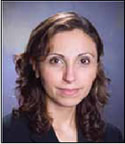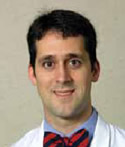As the 10-year anniversary of the Clinical Research Training Institute approaches, ASH highlights two early participants. Dr. Ghobrial participated in 2003 (the inaugural year), and Dr. Blum participated in 2004.
Assistant Professor of Medicine, Dana-Farber Cancer Institute, Harvard Medical School
If someone had told me 15 years ago that I would be a faculty member at Dana-Farber Cancer Institute as a principal investigator with a laboratory and clinical trials, I would have laughed at them. After all, I was a medical student at Cairo University School of Medicine. I knew that if I worked hard, I could go to the United States to get into a residency program so that I could receive top-notch training and a cutting-edge education. I never thought that my journey would take me to Harvard Medical School, and I did not know that the American Society of Hematology (ASH) would help me achieve this unimaginable dream.
During my hematology/oncology training at Mayo Clinic, I learned about clinical trials and clinical research as well as translational research. I was fascinated by the research that was going on around me, and I wanted to be part of it. I credit my great mentors who believed in me and who cared enough to improve my career path. I remember going to my first ASH annual meeting in Philadelphia. There was a snowstorm and some of the Plenary Scientific Session speakers could not make it. I was fascinated and overwhelmed by the scientific discoveries, the opportunities for research, and the great achievements of the scientists and clinicians around me. What I loved most about the ASH meeting was that science and clinical application were presented hand-in-hand. The meeting attendees felt like a great community who were enjoying creating new scientific discoveries. I knew from that first meeting that I would be an ASH advocate for the rest of my life. I was in love with a society that represented everything I believed in, so when I saw the email requesting applications for the first ASH Clinical Research Training Institute (CRTI), I pounced on the opportunity.
It will sound like a cliché to say that my experience in CRTI shaped my life. I remember talking with Jim George about my interest in academic medicine and trying to land a job during my third year in fellowship. I also remember talking to Beverly Mitchell about science and discovery. I was inspired by Brian Druker discussing his stories of failure before succeeding in his work on imatinib. From that point on, the faculty of CRTI, including past presidents of ASH, became my mentors who wrote letters of recommendation for me, and who helped me in my decisions regarding jobs, interviews, and NIH grant submissions. They were my new academic family. I was encouraged to write grants while I was at CRTI, and soon after returning from the initial one-week training, I started applying for the ASH, Multiple Myeloma Research Foundation (MMRF), Leukemia and Lymphoma Society (LLS), and American Society of Oncology (ASCO) grants.
I am now a faculty member at Dana-Farber Cancer Institute. I have received multiple R01 grants from NIH and FDA along with grants and awards from professional societies and nonprofit organizations. I have a lab full of young postdoctoral fellows, technicians, and students and a clinical practice with five active clinical trials, and a great clinical team of research nurses and clinical research coordinators. I am still working hard, hoping to make a significant contribution in the discovery and treatment of multiple myeloma and Waldenström macroglobulinemia. I have my daily challenges in life, but I occasionally have to pinch myself when I think that just a few years ago I was a student in a developing country with no research training and now I am a faculty member of the Harvard Medical School. I believe that my mentors and the ASH community have made this dream come true for me and for many others. I know that whenever the ASH leadership asks me to do anything for the Society, I can never say no, as I will never be able to pay back what ASH has made possible for me.
William Blum, MD
Associate Professor of Medicine, The Ohio State University and James Cancer Hospital
I have always liked looking at blood. Even from my preteen years in grade school, I have been fascinated by blood and the peripheral blood smear. Except for a few wayward years when I thought about being an astronaut, my career plans were focused on medicine and ultimately the care of patients with leukemia. I have been fortunate to have had mentorship and serendipity cooperate in leading me toward the career that I envisioned during my youth. As an undergraduate at Notre Dame in 1989, I needed a job. As luck would have it, Dr. Morris Pollard, a world-renowned virologist and cancer researcher, needed a lab assistant. My years with Dr. Pollard exposed me to research in animal models of cancer and the scientific method. Perhaps most importantly, I learned the impact that a mentor can have on a career and a life. One spring day, I came in to work and Dr. Pollard asked me what my summer plans were. I was planning to return home and get a job at the lake just like past summers, but he had a different plan for me. Through his intercession, I was accepted into the Baylor (Houston) summer research program and had the pleasure of working in the Tumor Biology department at M.D. Anderson Cancer Center in the lab of Dr. Douglas Boyd. It was a completely different laboratory experience than what I had seen up to that point. At the time, I thought my project focused on mechanisms of cancer cell migration/metastasis; I realize now that the “project” was me.
Beyond the tremendous experience of talking with Dr. Boyd every day about science or the personal experiences of living with other like-minded students in the heart of Houston, my time there deepened my interest in hematology. The Boyd lab happened to be right around the corner from a small auditorium where taped to the door was a schedule for the hematology fellows to give and/or hear lectures on hematology topics of interest. My schedule was reasonably flexible, so whenever the topic was leukemia, I slipped in the back door. I was hooked on hematology.
Both Drs. Boyd and Pollard helped open the door for me to another research experience — the summer student research program for the following year at The Jackson Laboratory in Bar Harbor, Maine. Living with other students on the coast of Mt. Desert Island in a mansion bequeathed to the lab within walking distance of Acadia National Park is not a bad way for a college junior to spend a summer. I was fortunate to land in Dr. Dave Harrison’s lab. Dr. Harrison and his wonderful assistant, Mike Astle, studied hematopoietic stem cells. I worked (unsuccessfully) for the summer trying to identify a unique, hematopoietic stem cell-specific surface marker. If ever there was a “successful failure” for me, this was it. An intense environment, but one of cooperation and collegiality, permeated both the Harrison lab staff and the students in the mansion. Students from all walks of life and nationalities lived together united in a desire to learn how things work. We and the senior scientists met regularly in small group sessions about our various research projects (or hiking trips); these were the highlights of the summer experience. I don’t remember too many of the topics. But I do remember the meetings; they became for me a model of how to foster cooperation among sometimes disparate groups of people to achieve a collective goal, and one that I have carried forward with me in both research environments and the care of patients.
Ultimately, I reached the point when I needed to decide where I would primarily spend my time, the clinic or the lab. For me, I did not feel that “both” was the right answer. To make my decision, I took the advice of Dr. Andy Albritton at the Medical College of Georgia who asked me, “What do you like to read?” I realized that my interests lay in taking care of patients, not in the old or traditional ways but rather in translating laboratory discoveries into the clinic. Later, I became involved in the American Society of Hematology Clinical Research Training Institute (CRTI) at the encouragement of Dr. Jim George, then president of the Society. With the aid of my still mentor and now friend Dr. Guido Marcucci, I developed a clinical trial with a hypomethylating agent for older patients with acute myeloid leukemia; this project has become a cornerstone for my ongoing research, with clinical or laboratory surprises and discoveries seemingly at every turn. I have since tried to fashion a career in bringing new drugs to patients, working closely with laboratory colleagues at The Ohio State University and James Cancer Hospital in a very productive loop that is an excellent example of bedside-to-bench-to-bedside clinical research in practice. Finally, no “summary of my academic journey” would be complete without the acknowledgment that my primary achievements live back home in our house in Worthington, Ohio. I have missed many activities through the call of work and science, but I have also sacrificed work time to coach soccer, throw the ball, or from time to time go with my lovely wife (the better looking and smarter other Dr. Blum) out to dinner.


